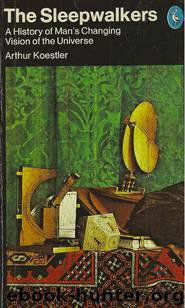The Sleepwalkers by Arthur Koestler

Author:Arthur Koestler [Koestler, Arthur]
Language: eng
Format: epub, mobi
Published: 2012-04-20T04:08:43+00:00
Yet the last step which had got him out of the labyrinth had once again been a faulty step. For it is not permissible to equate an area with the sum of an infinite number of neighbouring lines, as Kepler did. Moreover, he knew this well, and explained at length why it was not permissible. 21 He added that he had also committed a second error, by assuming the orbit to be circular. And he concluded: "But these two errors – it is like a miracle – cancel out in the most precise manner, as I shall prove further down." 22
The correct result is even more miraculous than Kepler realized, for his explanation of the reasons why his errors cancel out was once again mistaken, and he got, in fact, so hopelessly confused that the argument is practically impossible to follow, as he himself admitted. And yet, by three incorrect steps and their even more incorrect defence, Kepler stumbled on the correct law. 23 It is perhaps the most amazing sleepwalking performance in the history of science – except for the manner in which he found his First Law, to which we now turn.
7. The First Law
The Second Law determined the variations of the planet's speed along its orbit, but it did not determine the shape of the orbit itself.
At the end of the Second Book, Kepler had acknowledged defeat in his attempts to define the Martian orbit – a defeat caused by a discrepancy of eight minutes arc. He had then embarked on an enormous detour, starting with the revision of the earth's motion, followed by physical speculations, and terminating in the discovery of the Second Law. In the Fourth Book he resumed his investigation of the Martian orbit where he had left off. By this time, four years after his first, frustrated attempts, he had become even more sceptical of orthodox dogma, and gained an unparalleled skill in geometry by the invention of methods all his own.
The final assault took nearly two years; it occupies chapters 41 to 60 of the New Astronomy. In the first four (41-44), Kepler tried for the last time, with savage thoroughness, to attribute a circular orbit to Mars and failed: this section ends with the words:
"The conclusion is quite simply that the planet's path is not a circle – it curves inward on both sides and outward again at opposite ends. Such a curve is called an oval. The orbit is not a circle, but an oval figure."
But now a dreadful thing happened, and the next six chapters (45-50) are a nightmare journey through another labyrinth. This oval orbit is a wild, frightening new departure for him. To be fed up with cycles and epicycles, to mock the slavish imitators of Aristotle is one thing; to assign an entirely new, lopsided, implausible path for the heavenly bodies is quite another.
Why indeed an oval? There is something in the perfect symmetry of spheres and circles which has a deep, reassuring appeal to the unconscious – otherwise it could not have survived two millennia.
Download
This site does not store any files on its server. We only index and link to content provided by other sites. Please contact the content providers to delete copyright contents if any and email us, we'll remove relevant links or contents immediately.
Tools of Titans by Timothy Ferriss(7811)
Turbulence by E. J. Noyes(7700)
Astrophysics for People in a Hurry by Neil DeGrasse Tyson(5000)
Secrets of Antigravity Propulsion: Tesla, UFOs, and Classified Aerospace Technology by Ph.D. Paul A. Laviolette(4990)
Design of Trajectory Optimization Approach for Space Maneuver Vehicle Skip Entry Problems by Runqi Chai & Al Savvaris & Antonios Tsourdos & Senchun Chai(4839)
Room 212 by Kate Stewart(4733)
Pale Blue Dot by Carl Sagan(4613)
The David Icke Guide to the Global Conspiracy (and how to end it) by David Icke(4379)
A Journey Through Divination and Astronomy by Publishing Pottermore(4248)
Apollo 8 by Jeffrey Kluger(3512)
Goodbye Paradise(3446)
Losing the Nobel Prize by Brian Keating(3425)
COSMOS by Carl Sagan(3346)
The Five People You Meet in Heaven by Mitch Albom(3334)
How to Read Water: Clues and Patterns from Puddles to the Sea (Natural Navigation) by Tristan Gooley(3239)
Brief Answers to the Big Questions by Stephen Hawking(3239)
How to Read Nature by Tristan Gooley(3077)
The Order of Time by Carlo Rovelli(3073)
A Brief History of Time by Stephen Hawking(2819)
